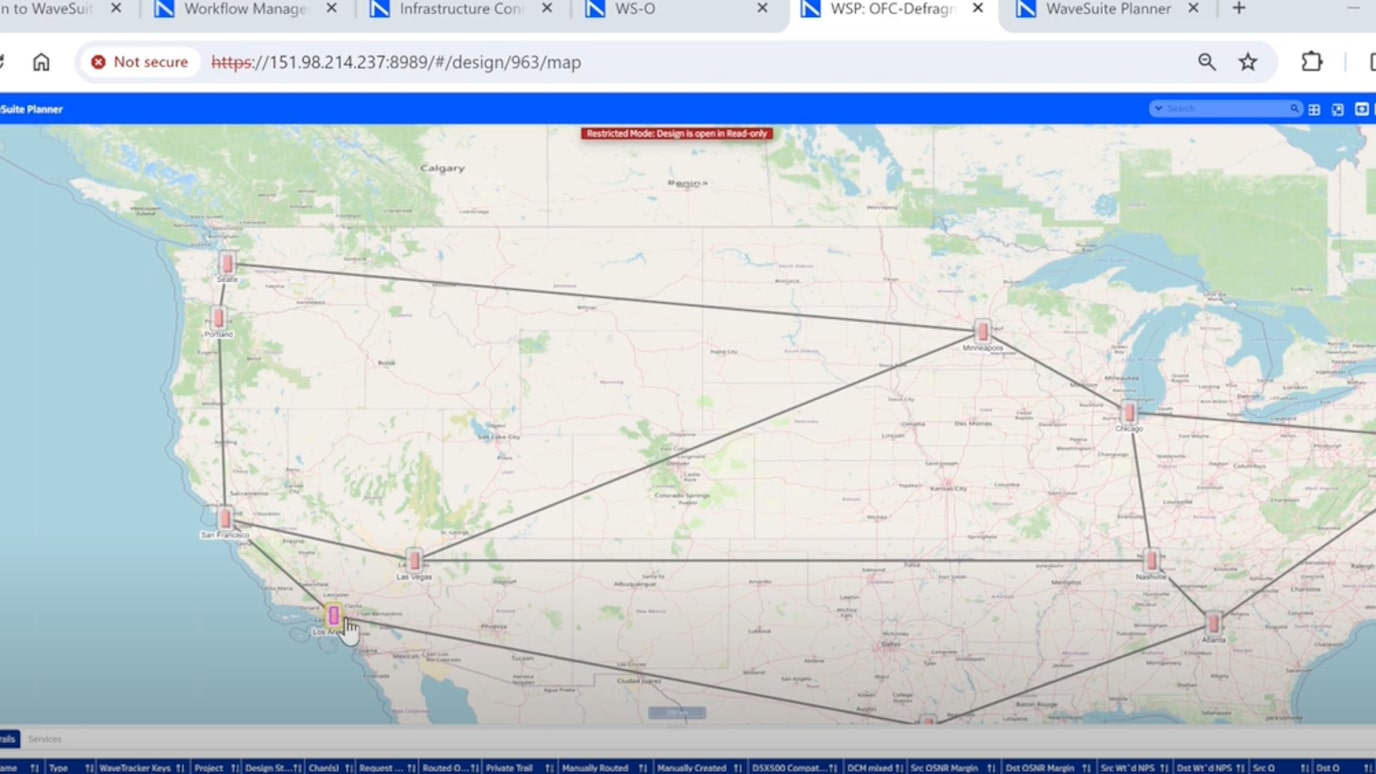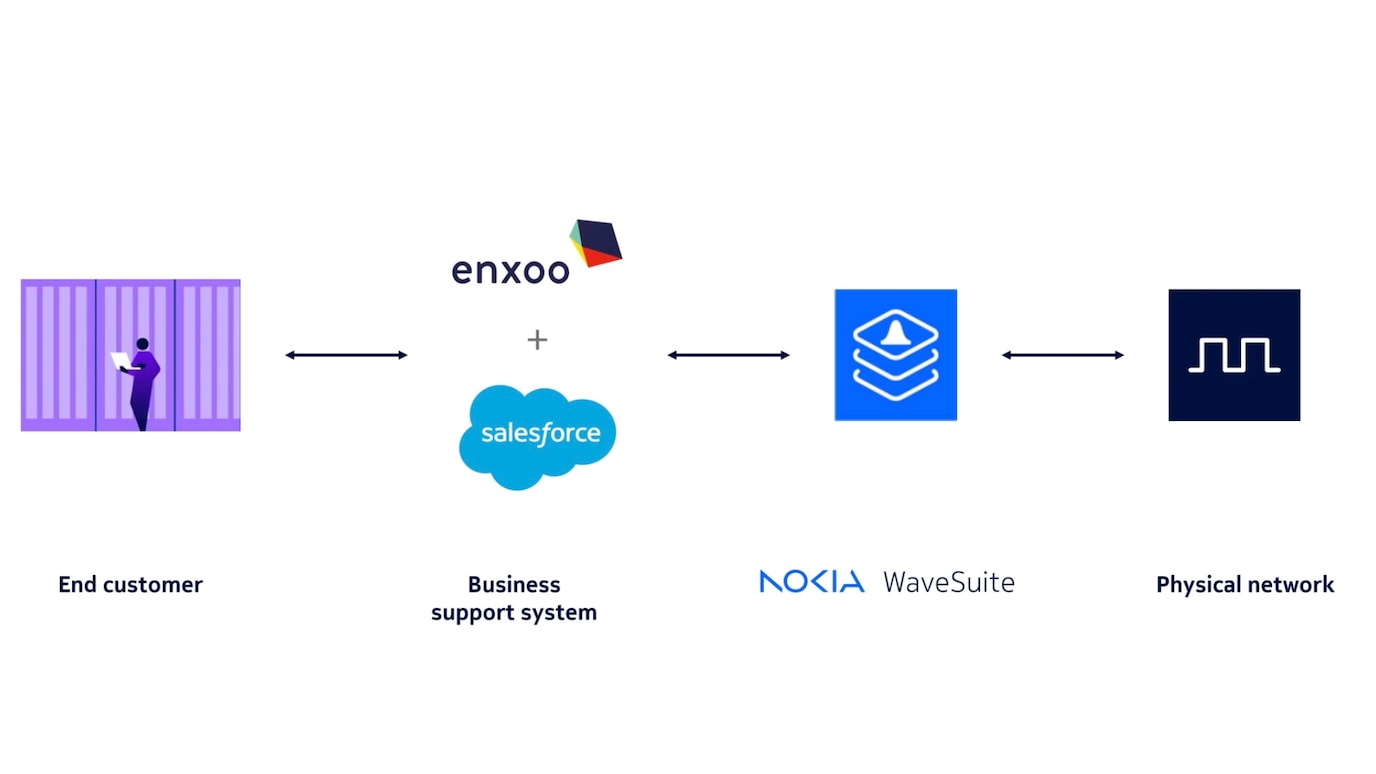Optical network automation
Optical transport is the backbone of global communications, and we’re asking more and more from it: carry more data; support more applications and devices; and provide secure, reliable, high-performance, low-latency connectivity on demand.
To meet these demands, you need to optimize your optical network for operational efficiency, scale it in line with demand and monetize its assets faster than ever. This means making constant changes to the network.
Manual processes can't manage these changes with the required speed and accuracy while continuing to deliver reliable, secure and efficient data transmission. You need optical network automation that can simplify network management, improve network resilience and performance, and keep total cost of ownership (TCO) low. This is the "simple" part of what Nokia calls scale made simple.
Open, Automated, and Programmable Transport Networks
Learn more about the key drivers for transport network automation.
Nokia partnered with Heavy Reading and other industry leaders to investigate the opportunities and challenges of adopting automation in transport networks. The survey delves into multiple topics that are top of mind for network operators, including:
- Transport automation use cases and benefits
- IP and optical convergence (IP over DWDM)
- Optical layer automation
- AI and ML in automation
What is optical network automation?
Optical network automation lets you combine domain-specific software and technologies to digitalize operational processes so you can manage network equipment and simplify network-driven tasks. You can use optical network automation to:
Streamline network operations
Improve efficiency
Reduce human intervention and potential errors
Enhance network performance
Shorten time to market for new services
Generate more revenue from your network infrastructure.
You can apply network automation to every stage of network operations and service delivery, from planning, to commissioning and provisioning, to analyzing and optimizing the network traffic and infrastructure.
Automation helps you create a new kind of network that is more responsive, efficient and reliable—and simpler to operate. With technologies such as model-driven mediation, intent-based networking and baseline analytics, you can create multivendor networks that can self-configure, optimize their performance in real time and recover from failure events on their own.
What are the drivers for optical network automation?
Service providers are adopting optical network automation to make their network infrastructure more efficient and scalable. They can use automation to quickly reoptimize their resources to adapt the network to new customer requirements. Automation can also predict, detect, analyze and react to any issues in the network to reduce the time needed for repairs.
The key drivers for adopting optical network automation include:
Reducing human error: Automation makes it easier to manage the multiple layers, technologies and components of optical networks and reduces the risk of issues created by human error.
Increasing resiliency and uptime: Automation can predict or detect and then responding to faults or security threats in real time. This reduces downtime and improves service availability.
Improving customer experience: Customers expect to be able to adjust their optical network services on demand to meet their dynamic requirements. Automation can reduce service provisioning time from weeks or months to hours, and improve overall quality of service and customer satisfaction as a result.
Simplifying operations and reducing OPEX: Automation helps operators reduce manual interventions and speed up network provisioning, troubleshooting, diagnostics and maintenance. This makes operations more efficient and less costly.
Network operators are also adopting automation to:
- Efficiently manage rising data traffic and network complexity
- Optimize routing and resource allocation
- Offer new services or adopting new business models, such as Network-as-a-Service
- Reduce energy consumption by dynamically adjusting network elements and routes and,
- Digitalize operations and business support systems (OSS/BSS) using open standard interfaces.
What are challenges to adopting optical network automation?
Optical network automation can provide many benefits, but you will face obstacles and challenges as you adopt it. These can vary based on your network, organization and regulatory environment. The top challenges include:
- Difficulty integrating automation tools with existing networks: Automating a deployed network can be complex, particularly if it contains equipment and software from multiple vendors. You may need to choose applications that support open standard initiatives, add new network planning capabilities and conduct automation integration tests..
- The potential to affect existing operations: Introducing automation to large and complex optical networks can bring significant challenges relating to orchestration, scalability and robustness. You need comprehensive testing and validation to ensure automation solutions deliver your required business outcomes, can integrate into your OSSs and BSSs, allow for customization and don’t introduce errors or vulnerabilities. These can be time-consuming and resource-intensive tasks.
- Cost: Deploying optical network automation often requires additional investments in software, hardware and workforce training. It’s a good idea to define how you will achieve return on investment before you allocate resources and budget to an automation initiative.
- Lack of clear use case objectives: It can be difficult to gain an understanding of your end-to-end network operations, IT systems or subscriber business requirements for automation. Prioritizing which network operation or process to automate can slow progress, drive additional costs and limit your revenue potential.
You can overcome these obstacles with careful planning, investment, collaboration and a commitment to a long-term vision for optical network automation that spans your entire organization.
What are the key considerations for planning your optical network automation journey?
Optical network automation is a complex and strategic process that requires careful consideration of multiple factors. Here are four key things to keep in mind as you embark on your automation journey:
- Identify your business objectives: Start by defining clear business objectives and goals for automation, such as improving network efficiency, reducing operational costs or monetizing your network assets faster. You should also perform a cost–benefit analysis of your automation initiatives, from the initial investment to the long-term benefits. Defining measurable KPIs will help ensure your automation project delivers the expected ROI and business objectives.
- Assess your network capabilities: Comprehensively review your existing optical network. Understand its architecture, components and capabilities, as well as its limitations and the areas where automation could provide the most value. For example, does your network support a programmable, open, software-defined control layer to provide an open interface that enables easy integration with automation solutions?
- Assess your organizational skill set: Your staff will need specific skills and knowledge to design, implement and maintain automated systems. This may require you to invest in workforce training and implement an overall cultural and organizational change to support automated operations.
- Define the scope: Based on your business objectives, network and personnel skill set, decide which aspects of your optical network should be automated. Whether your focus is provisioning, monitoring, management, security or a combination of these, you may want to start with small, short-term projects to gain confidence and build expertise before considering long-term, large-scale automation goals.
Other considerations include choosing development tools that have the capabilities you need to achieve your automation goals, developing a thorough testing and validation plan, ensuring your automation solution complies with regulatory requirements, and defining a solution strategy that will enable you to seamlessly introduce new technologies as they become available.
You should also make sure you have adequate resources to complete your automation initiatives on time and on budget. Working with a professional services consultation and resource team from a trusted vendor with experience in complex automation projects can help reduce the time you spend on implementation and validation.
A well-thought-out and comprehensive plan will smooth your transition to an automated optical network environment, maximize the benefits of automation and minimize potential challenges and disruptions.
How does Nokia support optical network automation?
Nokia is the best partner for your optical network automation journey. We have a comprehensive portfolio of optical networking technologies, a suite of network automation applications and a professional services team with proven expertise in creating digital solutions. By combining these capabilities, we can help you deliver network automation that drives business outcomes, get more value from your network faster, and simplify your network operations as you scale.
Nokia WaveSuite applications build on our industry-leading optical networking hardware and silicon and incorporate machine-learning algorithms and expertise from Nokia Bell Labs. You can use them to optimize your network’s performance, scale it to meet dynamic customer demand and quickly monetize your existing and future investments in network assets.
If you need more resources to realize your automation vision, our optical professional services team is ready to help. They provide the expertise, tools and best practices you need to customize and expand automation solutions within your OSS/BSS platform. This can help streamline your processes and deliver insight-driven communication into the transport domain so you can use it to boost productivity while you scale your business.
WaveSuite is one of the many automation solutions we offer. Beyond optical, you can integrate these solutions with orchestration platforms to support automation across your residential, fixed access, IP transport, and data center networks.
Optical network automation blogs
Related solutions and products
Service
Let us help you build scalable networks with ease through our professional services and rich eco-system of collaboration partners.
Learn more
Video
Accelerate Optical Service Deployment from Weeks to Minutes with WaveSuite
Video
Automate End-to-End Service Orchestration with Nokia WaveSuite & Enxoo
Video





















